Cyclone Idai: Death and Destruction from a Criminal System
| revcom.us
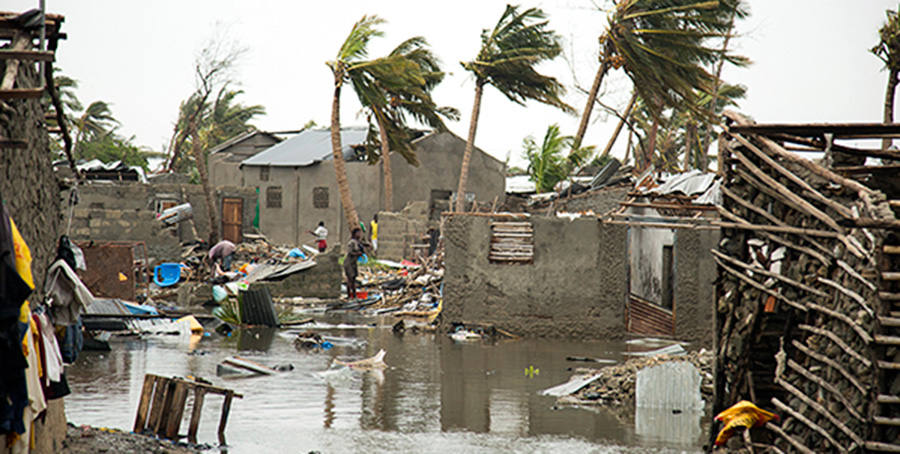
The burning of fossil fuels causes warming oceans and rising atmospheric temperatures, which allow the atmosphere to hold more water and increase the wind speed associated with cyclones. Cyclone Idai—the worst in 20 years—produced more than two feet of rainfall in parts of the region—nearly a year’s worth—in just a few days. (Photo: AP)
Yet another violent weather disaster is causing massive death and destruction. Last week, tropical Cyclone Idai ripped through the southern African nations of Mozambique, Malawi, and Zimbabwe. As of March 24, the official death toll in the three countries is more than 750, but the total number of those killed is expected to be much higher. CNN reports eyewitness accounts of 300 to 400 bodies lining the banks of a road out of Beira, Mozambique. Many bodies have been washed down rain-swelled rivers from Zimbabwe. The cyclone made hundreds of thousands homeless, and with the massive destruction of farms and roads, millions now face hunger and disease.
This is a glimpse of the future. With the warming of the planet, these kinds of extreme events will become more and more common. This then interacts with the way in which imperialism has retarded and distorted the development of roads, housing, and health care in the countries of Africa, Asia, the Middle East, and Latin America. And the result is millions vulnerable to death and devastation at a moment’s notice. What follows shows what we can expect will increase: unless we make revolution.
***
In scenes reminiscent of Hurricane Katrina in 2005, survivors of Cyclone Idai remain trapped on rooftops or in trees. Reports from many areas are just beginning to get out. “We don’t have anything,” Josef Marius Jafate, a 29-year-old farmer living in an improvised roadside camp, told the Guardian. “We don’t have rice, or flour or any clothes. We need shelter. When is the help going to come?”
“The situation is simply horrendous. There is no other way to describe it,” Elhadj As Sy, secretary general of the International Federation of Red Cross and Red Crescent Societies (IFRC), told the New York Times after touring camps for the displaced. “Three thousand people who are living in a school that has 15 classrooms and six, only six, toilets. You can imagine how much we are sitting on a water and sanitation ticking bomb.”
The response of the United States and other rich countries has been criminal. The U.S. has set aside a mere $700,000 for aid to the region! To put this into perspective, according to the Washington Post the cost of a single Trump trip to Mar-a-Lago is $3.4 million.
A Tale of Two Cyclones
At the same time as Cyclone Idai struck in southern Africa, what is called a “bomb cyclone” struck the central United States. There is massive flooding in Nebraska, Iowa, and Missouri. Rivers burst over more than 200 miles of barriers in four states, leaving three dead and hundreds of homes and farms destroyed.
Both storms were historic in size and intensity and caused significant damage, but why is it that three people died in the U.S. while the death toll from Cyclone Idai may reach into the thousands? Even allowing for possible differences in the size or intensity of the storms, this still seems way out of proportion. So what could account for the difference?
Centuries of colonialism and imperialism have left the people in the region poor and vulnerable. Mozambique, Malawi, and Zimbabwe are some of the poorest countries in the world. People live in houses with corrugated aluminum roofs that can blow away. Sixty-nine percent of the people live on less than $1.90 per day. (To get a deeper understanding of this, go here.)
But, again—why? Portugal colonized the region starting in the 1500s, robbing the country of its natural resources including gold, rubber, and ivory. “Settlers” were brought in, and the land was stolen from the people and given to Europeans. After the British abolished the slave trade in 1807, eastern Africa became central to the trade, with approximately one million slaves kidnapped from Mozambique during the 1800s and sold. This depopulated whole sections of the interior. Even after slavery was formally ended in Portugal in 1869, it continued de facto in Mozambique with forced labor used in mines and plantations until the beginning of the 20th century.
During the 20th century, the United States became the dominant imperialist power in the world. For decades, the U.S. supported and armed the racist apartheid regimes in South Africa and Rhodesia (now Zimbabwe). Between 1977 and 1992, South Africa and the United States funded a counterinsurgency war in Mozambique. Over one million Mozambicans were killed in the fighting or starved due to interrupted food supplies; an additional five million were displaced across the region. Much of Mozambique’s critical rural infrastructure—that is, its hospitals, rail lines, roads, schools, etc.—was destroyed.
Then, in the early 1990s, the U.S. and the other imperialist powers shifted gears and rearranged the form of imperialist domination in that part of the world—bringing in some of the very forces who had originally risen up to oppose colonialism to now preside over a new arrangement which maintained and even intensified the imperialist plunder (whatever the intent of some of the new forces in power). (To understand the dynamics involved in this, we strongly recommend Part IV of THE NEW COMMUNISM, by Bob Avakian, especially pp. 284-300.)
Under imperialism, Mozambique’s economy has been developed to produce sugar, cashew nuts, tea, and tobacco for the world market, while it must import food to feed its own people. The infrastructure of the region was developed not to serve the needs of the rural farmers but to enable Portugal and other imperialist powers to dominate and extract the wealth of the country. Even before the cyclone, malnutrition affected 43.7 percent of Mozambican children between the years 2005 and 2011.
With Idai, the agricultural output for the region has been ruined, leaving people facing starvation. There is a race against the clock as rescue workers struggle to gain access. However, the lack of infrastructure, the result of imperialist plunder, makes this difficult.
There is a threat of massive outbreaks of disease such as cholera spread by the lack of clean water. Sixty-three percent of the rural population does not have access to indoor water, and 90 percent does not have access to indoor sanitation during “normal” times. The minimal health care system that exists in the country is already overloaded, with over two million people with HIV and 46 percent of children in rural areas with malaria.
In 2016, the International Monetary Fund cut off aid to Mozambique, an action that greatly increased the suffering of the people. But while the people suffer, the imperialists and their puppets do just fine. Right now, the major international consortiums, led by ExxonMobil and others, are working to develop massive natural gas deposits off the coast to profit off the needs of a global economy dependent on fossil fuels. And within the U.S. itself, the entire economy sits on top of this global food chain, feeding off extreme misery in Asia, Africa, and Latin America, and it can finance relatively up-to-date infrastructure as a result.
All these factors combined to make the devastation far worse in southern Africa than it would be in any comparable storm in the U.S.
Why Are Violent Weather Events Happening More Often?
Weather-related disasters are occurring more frequently due to global warming, which is mainly caused by large-scale burning of fossil fuels (oil, gas, and coal) that produces carbon emissions. These industries are at the heart of the imperialist economy. The burning of these fuels causes warming oceans and rising atmospheric temperatures, which allow the atmosphere to hold more water and increase the wind speed associated with cyclones. Idai produced more than two feet of rainfall in parts of the region—nearly a year’s worth—in just a few days.
Partly as a result of the global warming caused by burning fossil fuels, the region had been suffering from a severe drought. Drought causes hardening of the soil, which leads to more intense flooding. Sea levels are about a foot higher than a century ago, which increases coastal flooding.
Who is responsible? Africa produces just four percent of global carbon emissions—compared to 80 percent by the most industrialized countries that make up the G20 (an organization of the world’s largest economies). Historically, through 2016, the U.S. has produced 2,575 times the carbon emissions and other greenhouse gases as Mozambique.
Revolution—Nothing Less
This system has ravaged Africa for hundreds of years. The slave trade, savage colonial rule, brutal white supremacist warfare, and the installation of imperialist puppet regimes have gone along with unbelievably ruthless exploitation. And THIS has created the conditions for the horrors we are seeing in Mozambique, Malawi, and Zimbabwe.
The system’s incessant burning of fossil fuels that feeds greenhouse gases into the atmosphere is putting the very future of life on the planet at risk. The countries least responsible for climate change, such as those hit by Cyclone Idai, suffer the most.
At this point, these imperialists are not even living up to their own phony agreements, which wouldn’t stop the problem in the first place. The ONLY answer their system really has to this is even greater devastation and horror for billions on this planet—and the killing of refugees, either on the high seas, the deserts, or through militarized “barriers.” The ONLY SOLUTION is a communist revolution, whose guiding principles include developing the economy in a way that contributes to “advancing the world revolution to uproot all exploitation and oppression and to emancipate all of humanity,” “protecting, preserving and enhancing the ecosystems and biodiversity of the planet for current and future generations” (from the Constitution for the New Socialist Republic in North America, authored by Bob Avakian), and overcoming the legacy of imperialist oppression of whole sections of the globe.
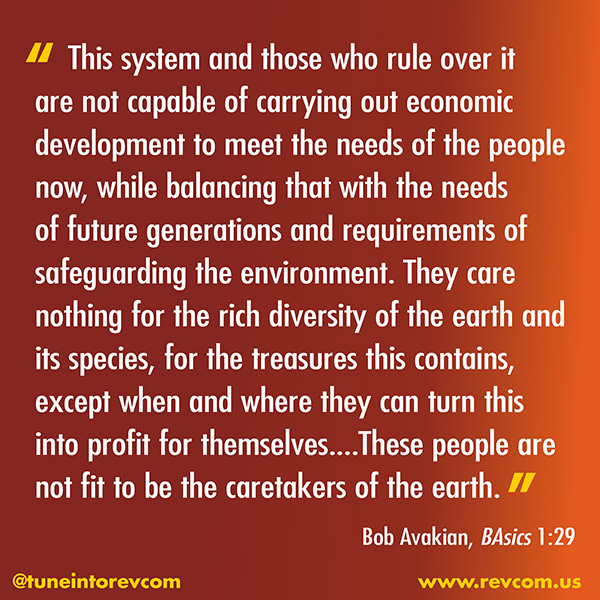
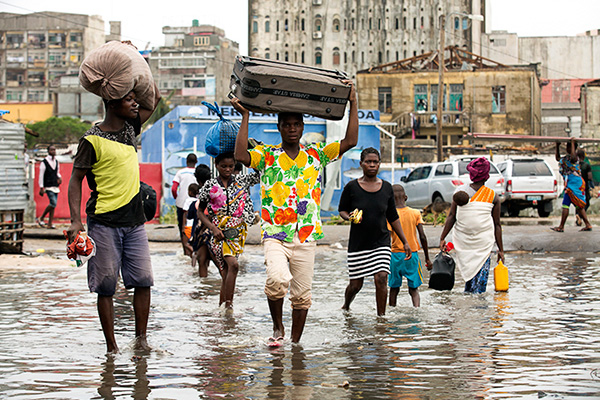
Hundreds of thousands of people were displaced by Cyclone Idai in Mozambique, Malawai, and Zimbabwe. Here people wade through flood waters to seek refuge in Beira, Mozambique, which was badly damaged by the weather. (Photo: AP)
“The Destruction of the Planet by Capitalism-Imperialism”
An Excerpt from
Why We Need An Actual Revolution And How We Can Really Make Revolution
A speech by Bob Avakian
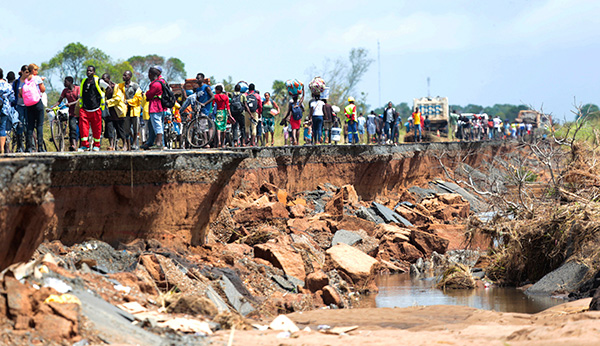
The infrastructure of the region was developed not to serve the needs of the rural farmers but to enable Portugal and other imperialist powers to dominate and extract the wealth of the country. With Idai, the roads and bridges suffered a devastating blow, and agriculture has been ruined, leaving people facing starvation. (Photo: AP)
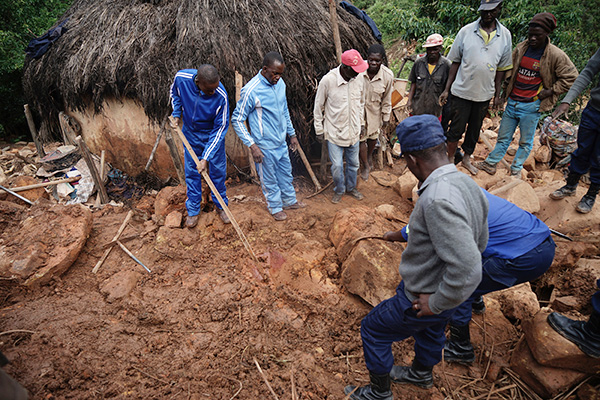
The region had been suffering from a severe drought. Drought causes hardening of the soil, which leads to more intense flooding after extreme storms because the soil cannot absorb the water. Here, after Cyclone Idai caused mudslides in Chimanimani, Zimbabwe, the people from the community search for those who were missing. (AP Photo/KB Mpofu)
See Also:
How Would a Revolutionary Socialist Society Address the Environmental Emergency?
Excerpts from the Constitution for the New Socialist Republic in North America
“You Think You’re Woke...
But You’re Sleepwalking Through A Nightmare —
This System Cannot Be Reformed, It Must Be Overthrown!”
The Get Organized for an ACTUAL Revolution Tour
Read about the Tour stepping up and stepping out »
Checks can be sent to:
RCP Publications, Box 3486, Merchandise Mart
Chicago, IL 60654-0486 (Mark for the Tour)
Get a free email subscription to revcom.us:

